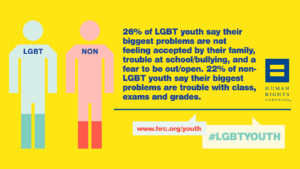Social Issues
Social Issues have existed for as long as society has. The people affected, the place, and the importance always changes over time. In modern-day, three social issues afflicting society include LGBTQ+ rights, homelessness, and the criminal justice system.

As for LGBTQ+ rights, there is a movement to be more inclusive and accepting for same-sex relationships, parenting, bias-free education, and non-discrimination protections. Unfortunately many reject the LGBTQ+ community. In fact, “Sexual orientation ranks as the third-highest motivator for hate crime incidents (17 percent of total attacks).” 1 Many times the reason behind this hate is due to religious beliefs that homosexuality and transgenderism are a sin. Personally I know many people who are not discriminatory but are anti-LGBTQ+, which makes for extremely awkward situations. I choose this topic because I believe people should be able to love who they love and be who they wish to be. No one has the right to stop people from having control over their bodies and relationships. One specific issue involves LGBTQ+ youth. There is a gross lack of education on sex and history as well as biased and unsafe schools. “Five population-based surveys of high school students found that bisexual, lesbian and gay youth reported strikingly higher rates of sexual abuse and forced intercourse than their heterosexual counterparts (Saewyc et al. 2006).” 2 “LGBTQ youth represent as much as 40% of the homeless youth population. Of that population, studies indicate that as many as 60% are likely to attempt suicide” 3 There is plenty of history that can be taught about movements in America, like Harvey Milk, as well as the history of LGBTQ+ around the world. There are numerous surveys and facts that support issues youth face. No matter your belief about homosexuality, the pain, and death that children face is an obvious failure by society.
The second issue faced by too many is homelessness. This is the greatest fear for many in the realm of economic issues. Too many times have I gone to a city and passed by someone who is struggling to survive.
The winter is especially bad, as homeless and left outside to the elements. This can affect anyone in my personal community or in the world. For those in this situation not due to their own agency shows how society has failed to help people. There is plenty of statistics on this subject. For example, “564,708 people experiencing homelessness on any given night in the US. 36,907 (6.38%) are children, 47,725 (8.33%) are veterans, and 269,991 (47.6%) are disabled and unable to work.” 4 AS for history, researching other subjects like unemployment, poverty, abuse, mental illness, substance abuse, children being kicked out of their homes and so on. Understanding that most homeless aren’t homeless due to lack of effort, but outside societal forces that they cannot overcome alone. Focusing on how children can become homeless or unemployment is a good way to explain how and why people lose their homes. This can help people have more empathy and understanding causing them to help out more. Many people blame victims or the homeless for their situation when other factors may play a major part.
The third and final social issue is the criminal justice system. Many debates have been fought over the dramatically increasing prison population, the cost of incarceration, the death penalty, and “revolving door in and out of prisons.”5 I choose this issue because crime affects everyone and the current system is not reforming prisoners. I also want to dive deeper into looking at why people commit crimes. For example, did they face abuse, did they not have access to education, are they impoverished, do they struggle with addiction and so on. Statistics on this topic are easily available and numerous studies have been done. As for history, one can look at the last few decades and look at how the criminal justice system has increased. For example, “the war on drugs” is just one example of how incarceration has changed. Something to focus on is the drastic inequality in representation. Men of color especially are shown as criminals and are concentrated in the inner cities. “The Bureau of Justice Statistics reports that 35% of state prisoners are white, 38% are black, and 21% are Hispanic.”6 Historically, possessing crack had more prison time than cocaine. People of color were more likely to have crack while whites were more likely to have cocaine despite them being practically the same drug. An interesting documentary called 13 goes in-depth about blacks in the criminal justice system. Police brutality and targeting based upon race is also connected to this social issue.
Overall, these issues affect many people and have been at the forefront of the current social issues facing America.
Work Cited
1 and 2 Marzullo, Michelle A, and Alyn J Libman. “Research Overview: Hate Crimes Against Lesbian, Gay, Bisexual, and Transexual People.” hrc.org. Human Rights Campaign Foundation, 2009. https://assets2.hrc.org/files/assets/resources/Hatecrimesandviolenceagainstlgbtpeople_2009.pdf?_ga=2.23063165.716889190.1581088277-332703889.1575742720.
3 “Youth Homelessness.” The Trevor Project. Accessed February 7, 2020. https://www.thetrevorproject.org/get-involved/trevor-advocacy/homelessness/.
4 “U.S. Homelessness Facts.” Front Steps, January 11, 2018. https://www.frontsteps.org/u-s-homelessness-facts/.
5 “Read ‘The Criminal Justice System and Social Exclusion: Race, Ethnicity, and Gender: Proceedings of a Workshop–in Brief’ at NAP.edu.” National Academies Press: OpenBook. Accessed February 7, 2020. https://www.nap.edu/read/25247/chapter/1#2.
6 Nellis, Ashley. “The Color of Justice: Racial and Ethnic Disparity in State Prisons.” The Sentencing Project, June 14, 2016. https://www.sentencingproject.org/publications/color-of-justice-racial-and-ethnic-disparity-in-state-prisons/.